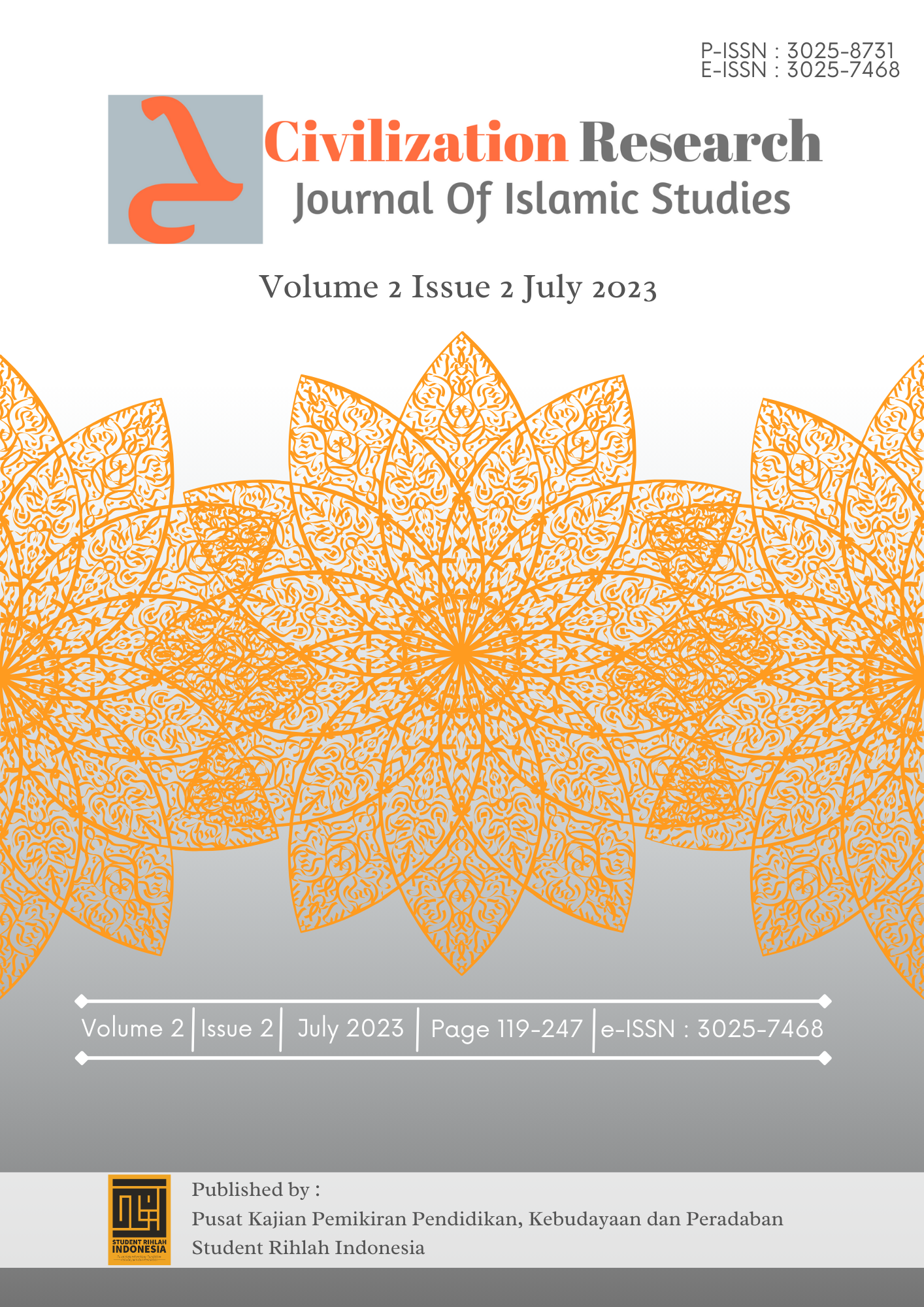Al-Manhaj Al-Qur’ānī Fī Mu’ālajaħ Zāhiraħ Mā Ba’da Al-Haqīqaħ المنهج القرآني في معالجة ظاهرة ما بعد الحقيقة
محتوى المقالة الرئيسي
الملخص
This research proved that post-truth has basic characteristics in this era, including: the spread of Hoax easily, the death of experience, and the presence of irritability of the people, and proved that the reason for all this is ignorance of the people, especially in their interest in reading and searching for the truth with a lack of awareness of that, and another reason is the lack of focus by the government in the face of the phenomenon of post-truth. This research revealed Quranic solutions to the issue, first, social monitoring by the government and the people to reduce the seriousness of the post-truth effect, Second, developing the educational quality in the hearts of the people to distinguish between right and wrong and be able to control the speed of emotion when searching for the truth and not forget the objective truth, so that the phenomenon of post-truth is what indicates the circumstances in which objective facts have less impact on public opinion compared to the influence of tendencies, emotions and personal beliefs.
تفاصيل المقالة

هذا العمل مرخص بموجب Creative Commons Attribution-ShareAlike 4.0 International License.
You are free to:
- Share — copy and redistribute the material in any medium or format for any purpose, even commercially.
- Adapt — remix, transform, and build upon the material for any purpose, even commercially.
- The licensor cannot revoke these freedoms as long as you follow the license terms.
Under the following terms:
- Attribution — You must give appropriate credit , provide a link to the license, and indicate if changes were made . You may do so in any reasonable manner, but not in any way that suggests the licensor endorses you or your use.
- ShareAlike — If you remix, transform, or build upon the material, you must distribute your contributions under the same license as the original.
- No additional restrictions — You may not apply legal terms or technological measures that legally restrict others from doing anything the license permits.
Notices:
You do not have to comply with the license for elements of the material in the public domain or where your use is permitted by an applicable exception or limitation .
No warranties are given. The license may not give you all of the permissions necessary for your intended use. For example, other rights such as publicity, privacy, or moral rights may limit how you use the material.
المراجع
‘Abd Ar-Raḥmān As-Sa’dī, Taysīr Al-Karīm Ar-Raḥmān Fī Tafsīr Kalām Al-Mannān, (Beirūt: Mu’assasah Ar-Risālah, 1420 H), 673
Abd Al-Ghanī, Abū Al-‘Azm, Mu’jam Al-Ghanī, (Beirūt: Dār Al-Kutub Al-‘Ilmiyyah, 2013) 709
Abū Al-Fida’ Ibn Kaṡīr, Al-Bidāyah Wa An-Nihāyah, (Al-Gīza: Dār Hijrah Li Aṭ-Ṭibā’ah Wa An-Nasyr Wa At-Tawzī’ Wā Al-I’lān, 1424 H), 173
Abū Al-Fidā’ Ibn Kaṡīr, Qaṣaṣ Al-Ānbiyā’, (Kairo: Maṭba’ah Dār At-Ta’līf, 1388 H), 1/14
Abū Al-Fida’ Ibn Kaṡīr, Tafsir Al-Qur’an Al-‘Azim, (Ar-Riyad Dar Taybah Li An-Nasyr Wa At-Tauzi’, 1420 H), 6/487
Al-Ḥusain Bin Mas’ūd Al-Baghawī, Ma’ālim At-Tanzīl Fī Tafsīr Al-Qur`ān, (Beirūt: Dār Ihyā` At-Turaṡ Al- ‘Arabī, 1420 H), 2/182
Al-Qur’ān Al-Karīm, Ḥafṣ Sayyid IT For Microsoft Word Application
Curtis D MacDougall, Hoaxes (Dover: Dover Publications Inc, 1958), 6
Ibn ‘At{iyyah, Al-Muh{arrar Al-Wajiz Fi Tafsir Al-Kitab Al-Aziz, (Beirut: Dar Al-Kutub Al-‘Ilmiyyah, 1422 H) 3/94-95
Ibn Jarir At-Tabari, Jami’ Al-Bayan ‘an Ta’wil Ay Al-Qur’an, (Al-Gīza: Dār Hijrah Li Aṭ- Ṭibā’ah Wa An-Nasyr Wa At-Tawzī’ Wā Al-I’lān, 1422 H), 19/195
Jabīr Bin Mūsā Al-Jazā`irī, Aysar At- Tafāsīr Li Kalāmi Al-‘Aliy Al-Kabīr, (Al-Madīnah Al- Munawwarah: Maktabah Al-‘Ulūm Wa Al-Hukm, 1424 H), 1/43-44 ‘Izzuddīn Bin Al-Aṡīr, Al-Kāmil Fī At-Tārīkh, (Beirūt: Dār Al-Kutub Al-‘Arabiy, 1417 H), 28
Jamāl Ad-Dīn ibn Manẓur, Lisānul ‘Arab, (Beirūt: Ihya` At- Turāṡ, 1999) 11/724
Marc Sagnol, Le statut de la sociologie chez Simmel et Durkheim, (Paris: Revue française de sociologie, 1987) 99-125
Muh{ammad At-Tahir Bin ‘Asyur, At-Tahrir Wa At-Tanwir, (Tunis: Ad-Dar At-Tu>niyyah Li An-Nasr, 1984 H)
Muhammad Bin ‘Umar Ar-Razi, At-Tafsir Al-Kabir,(Beirut: Dar Ihya’ At-Turas Al-‘Arabi, 1420 H)
Muhammad Bin Ahmad Al-Qurtubi, Al-Jami’ Li Ahkam Al-Qur’an, (Kairo: Dar Al-Kutub Al-Misriyyah, 1348 H), 8/288-289
Muḥammad Al-Amīn Bin Muḥammad Al-Mukhtār Asy Syinqīṭī, Aḍwa` Al-Bayān Fī Īḍāh Al-Qur`ān Bi Al-Qur`ān, (Beirūt: Dār Al-Fikr, 1415 H), 7/411
Muḥammad Bin Abd Al- ‘Azīz Al-Khuḍairī, As-Sirāj Fī Bayāni Gharīb Al-Qur’ān, (Mamlakah Al-‘Arabiyyah As-Su’ūdiyyah: Maktabah Al-Malik Fahd Al- Waṭaniyyah, 1429 H), 222
Muḥammad Bin Yūsuf Bin Ḥayyān Al-Andalusī, Al-Bahr Al-Muḥīṭ Fī Tafsīr, (Beirūt: Dār Al-Fīkr, 1420), 9/513
Muslim Bin Al-Ḥajjāj An-Naysābūrī, Ṣahīh Muslim, (Miṣr: Dār Iḥyā’ Al-Kutub, 1374 H) 2607
Rita Puspita Sari, Strategi Komunikasi Jabar Saber Hoaks Dalam Menghadapi Berita Bohong Di Jawa Barat, Skripsi Ilmu Komunikasi, Universitas Pasundan, Bandung: 2019 hal 1
Rulli Nasrullah, Media Sosial Perspektif Komunikasi, Budaya, dan Sosioteknologi, (Bandung: Simbiosa Rekatama Media, 2017) h 11
Simon Kemp, DIGITAL 2022: INDONESIA, 15, February, 2022, Digital 2022: Indonesia — DataReportal – Global Digital Insights; accesed 13 November 2022
Umar, Ahmad Mukhtār, Mu’jam Al-Lughah Al-‘Arabiyyah Al-Mu’āṣirah, (Kairo: ‘Ālim Al-Kitāb, 1429 H) 2449
Unais, Ibrāhīm, Al-Mu’jam Al-Wasīṭ, (Kairo: Maktabah Asy-Syurūq Ad-Dauliyyah, 2004) 503

